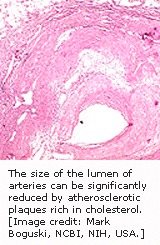NCBI Bookshelf. A service of the National Library of Medicine, National Institutes of Health.
National Center for Biotechnology Information (US). Genes and Disease [Internet]. Bethesda (MD): National Center for Biotechnology Information (US); 1998-.

Atherosclerosis is a disease that can affect people at any age, although it usually doesn't pose a threat until people reach their forties or fifties. It is characterized by a narrowing of the arteries caused by cholesterol-rich plaques of immune system cells. Key risk factors for atherosclerosis, which can be genetic and/or environmental, include: elevated levels of cholesterol and triglyceride in the blood, high blood pressure, and cigarette smoke.
A protein called apolipoprotein E, which can exist in several different forms, is coded for by a gene found on chromosome 19. It is important for removing excess cholesterol from the blood, and does so by carrying cholesterol to receptors on the surface of liver cells. Defects in apolipoprotein E sometimes result in its inability to bind to the receptors, which leads to an increase a person's blood cholesterol and consequently their risk of atherosclerosis.
Currently, a debate is raging over how the various mutated forms of apolipoprotein E affect the body. As a result, many of the treatments proposed remain in their experimental phase. While mice are proving useful for modeling the human disease, a great deal of research is still required before we can fully understand the mechanisms that regulate the levels of lipoproteins—like apolipoprotein E—in the blood.